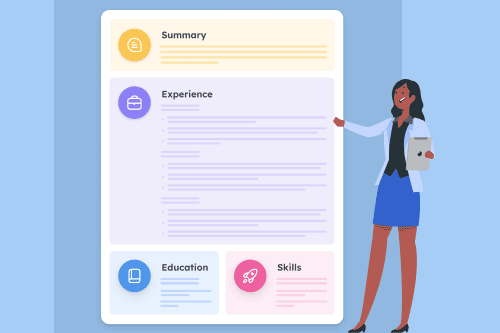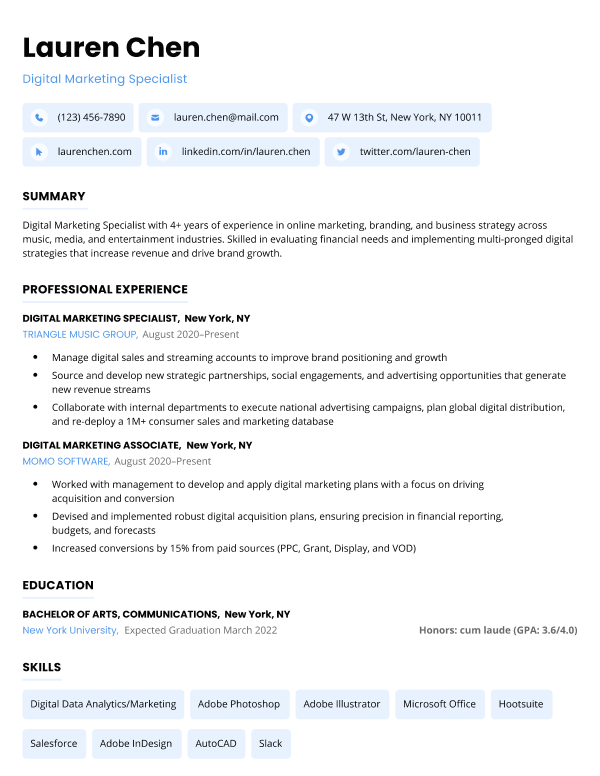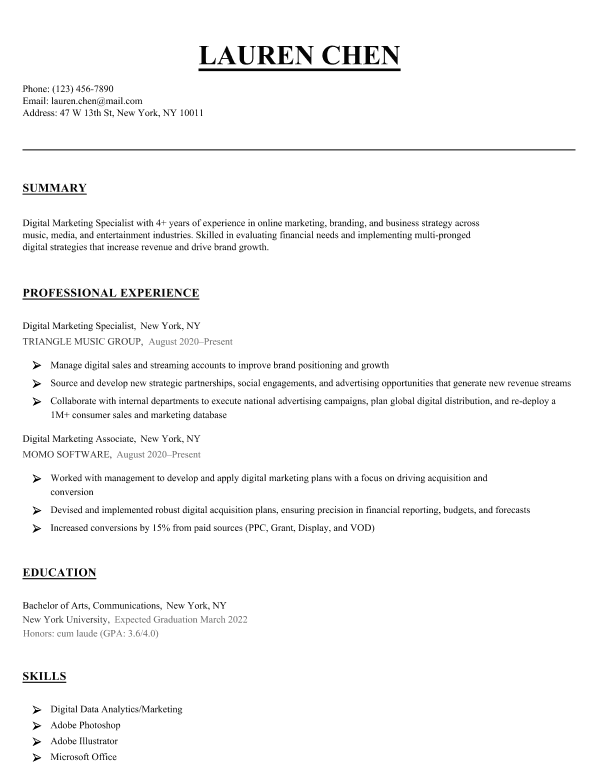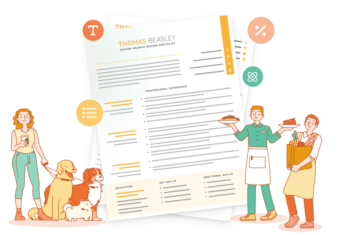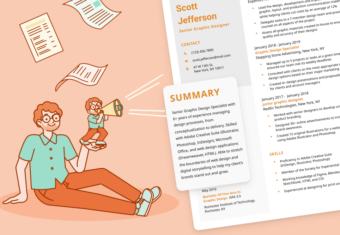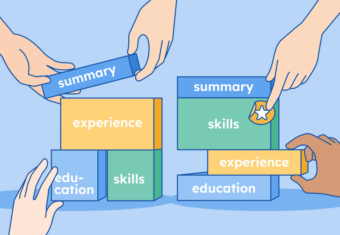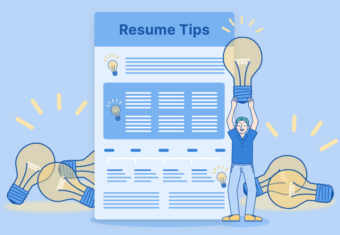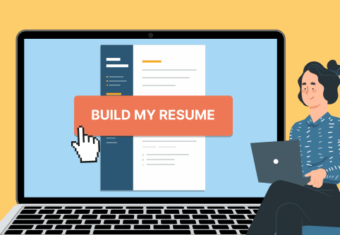Here’s what a good resume should look like in 2024:
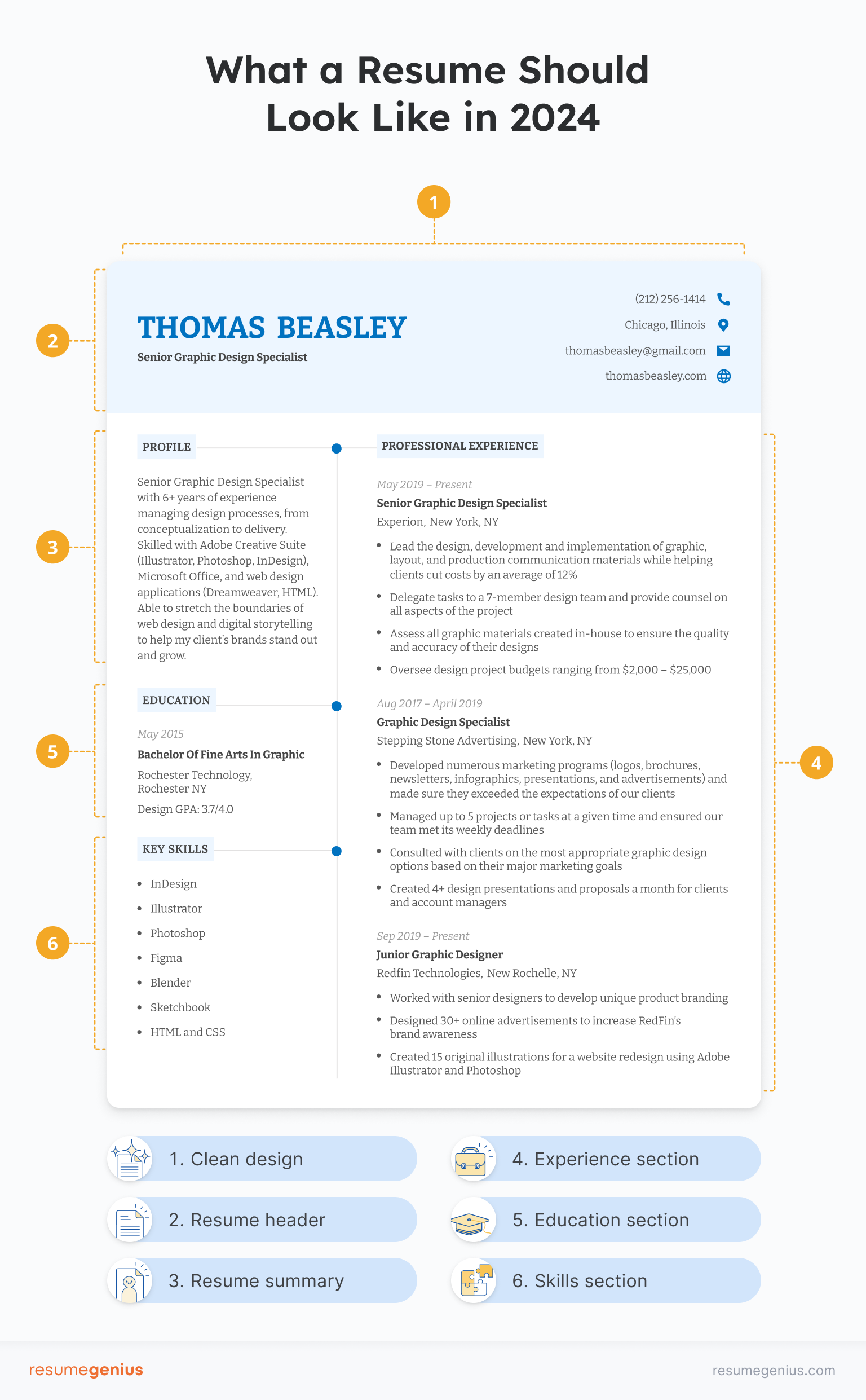
If you’re still unsure of what a resume is and how to make one that looks like this, Eva Chan, CPRW, explains what the three different types of resumes look like at the 16-second point of this video:
And to expand on what she mentions, here are 6 tips to make sure your resume looks good: Our free-to-use resume builder can make you a resume in as little as 5 minutes. Just pick the template you want, and our software will format everything for you.
1. Use a modern resume header
Just having your name in bold at the top was acceptable in the early 2000s, but modern resumes need more visual appeal to get noticed.
Begin your resume with an eye-catching resume header to ensure the hiring manager notices your application and remembers your name. For example:
A resume header like this is effective because its high contrast draws the eye to the candidate’s name, title, and contact information. Including your contact details in the header makes it easy for employers to know how to contact you.
To make sure your resume’s information is presented well, use a resume template that features a good-looking header and a modern layout.
2. Start with a resume summary
A good-looking resume always starts with a summary section. A resume summary is a short section at the top of your resume highlighting your key qualifications. It can be formatted either as a short paragraph of 3–4 sentences or as bullet points.
Use your resume summary to showcase your most relevant skills and achievements, and how you can benefit the company. Here’s an example:
Server Resume Summary
Courteous server with Food Handling and Safety Certification and 7+ years of experience of food preparation and service in 150+ seat restaurants. Generated additional daily wine sales of $150. Looking to leverage my strong customer service and sales skills to increase sales at [Company].
While not all job seekers include a resume summary, using one effectively can provide employers with the hook they need to take a deeper look.
3. Keep the design and fonts simple
When you’re trying to make a good-looking resume, it can be tempting to go overboard with the design. But it’s important to keep your resume simple, because more than 40% of recruiters don’t like resumes with too many design elements or creative fonts, according to the latest resume statistics.
If you’re applying for positions at large companies, it’s likely that they use applicant tracking systems (ATS) to screen candidates. Resumes with graphics or excessive design elements are too confusing for ATS software to process, so keep it simple with an ATS-friendly resume.
The best fonts for your resume are easy to read, like serif and sans serif fonts, and the sizing should be consistent between sections. For body text, choose a font size between 10 and 12.
Sticking with a simple font choice can keep your resume from looking too busy, and makes it easy for hiring managers to scan.
4. List work experience starting with your most recent job
Many hiring managers prefer chronological resumes because they demonstrate your career progression in a clear way.
While there are two other resume formats to choose from, you should use a chronological resume if your work experience is your strongest qualification.
A chronological resume works for all industries and experience levels, is conventional and easy to understand, and clearly demonstrates a vertical career progression. Unless you’ve had long periods of time out of work or are switching to a different industry, stick to the chronological resume format.
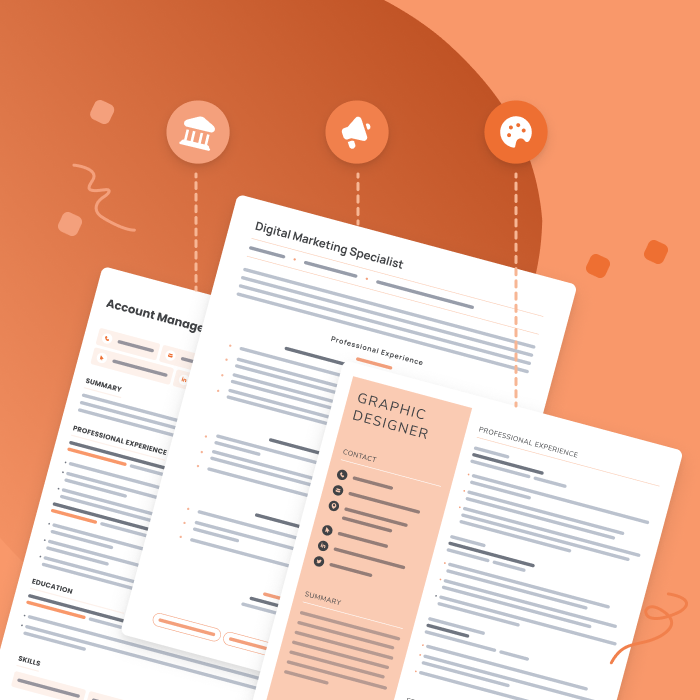
Resume examples for different industries
Not sure what your resume should look like? The best way to learn is by taking inspiration from resume examples written by other candidates in your industry.
5. Write a work history section with numbers and action verbs
Use numbers when listing your accomplishments on your resume. They’re eye-catching and show you have a history of delivering results.
Even if you didn’t work in a data-driven field, you can still find numbers in:
- How many customers or clients you served
- How many new hires you helped train
- What percentage increase in sales or efficiency you achieved
- How much money you saved (or earned) your company
- How much time you’ve saved by streamlining processes
Here’s how that should look on a resume:
Acme Inc., Hilo, HI / July 2016—April 2020
- Provided basic technical support for clients on a wide range of company products, resolving issues at a 90% rate
- Received an average 85% customer satisfaction rating to date, 15% higher than company average
- Handle 90+ calls daily, with duties including signing up new customers, retrieving customer data, presenting relevant product information, and canceling services
- Suggested a new tactic to persuade canceling customers to stay with the company, resulting in a 5% decrease in cancellations
Also, focus on achievements rather than responsibilities. Bullet points that begin “responsible for” don’t tell the hiring manager much about what you achieved for your previous employer.
Instead, use powerful action verbs that describe why you excelled in the position. Here’s an example of work experience with the actions verbs (in bold):
Green & Lopez Ltd., Broken Arrow, OK / September 2010–July 2014
- Spearheaded new 10-minute stand-up meetings initiative that increased productivity and reduced wasted time
- Organized transportation to 47 conferences, seminars, and conventions per quarter
- Liaised between CEO and subordinates/clients to ensure optimal use of her time
6. Add resume keywords to each resume section
Resume keywords are the skills and qualities hiring managers say they’re looking for in the job posting.
Including them in your resume quickly shows employers that you know what they’re looking for and that you’re a great match for the position.
Use specific, tailored keywords throughout your skills section, work history, and resume summary. While you should use them wherever appropriate, don’t stuff your resume with keywords.
Example of what a resume should look like
The best-looking resumes have a clear structure and simple design that draw attention to your professional accomplishments.
Here’s one of our favorite templates, a great example of how a resume should look:
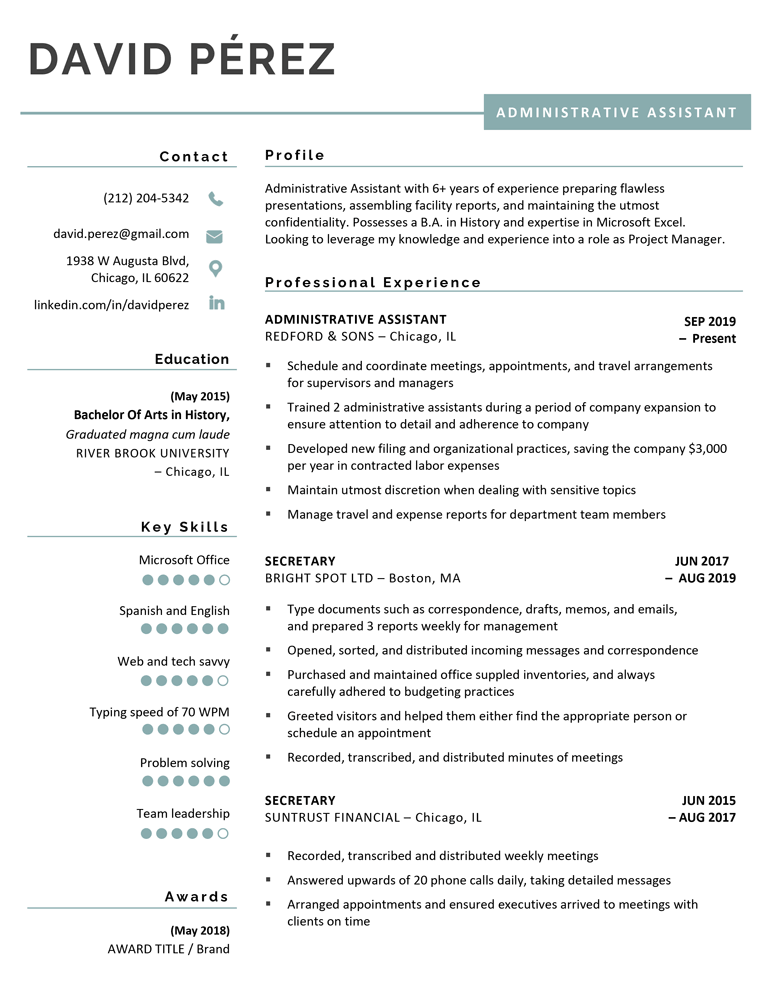
Build your resume in minutes Use an AI-powered resume builder and have your resume done in 10 minutes. Just select your template and our software will guide you through the process.
Now you know what it should look like, start writing your resume (just don’t forget to write a cover letter too). Happy job hunting!
Frequently asked questions about how a resume should look
Still unsure what makes a good-looking resume? Check out these commonly-asked questions below for more answers:
When should you put a photo on your resume?
You should put a photo on your resume when the job you’re applying for requires it (for example, if you’re writing a model resume or an acting resume), or it’s standard practice to include a resume photo in your country.
In the US it’s best to avoid including a photo on your resume. Most employers don’t want to take the chance with resume photos, as they can potentially lead to discrimination charges.
However, it’s commonly accepted (or even required) to include a photo on a CV in many European and Asian countries.
How should I lay out my resume?
You should lay out your resume in a way that highlights your key strengths as a candidate.
Use a resume introduction at the top to give an overview of your most important qualifications, and then structure the rest of your resume according to what’s most relevant for the job.
If you’re writing a new graduate resume without much professional experience, for example, your education section will likely be very valuable and should be placed near the top. It may even include extra information such as academic awards, relevant coursework, or your dissertation.
If your technical skill set is what makes you the best candidate for the job, use a technical skills section at the top of your resume to show employers you’re a good match.
Click to rate this article
4.8 Average rating


